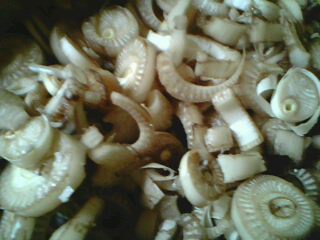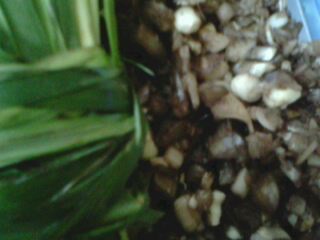Last Saturday, my Mom came back from our hometown Bacolod City after an important business matter. She brought with her treats from the all-famous Bong-Bong’s like a lot of piaya, pinasugbo and butter scotch. Along with her is another box containing the best achara or pickled unripe papaya ever made by my own grandma and what my tita requested as pasalubong, ubad. For those who are not familiar with what ubad is, I posted a picture taken from my Dad’s phone here…

For some who have been to simple kiddie parties in the province, you might be familiar with that plant stalk that they usually put as stands for the sticks of hotdog and marshmallows. That my friends is a banana stalk and ubad is the core of the banana’s body. It is where the water and nutrients that supply the banana plant pass. I am most familiar with how the Negrénses have come do discover that the banana core stalk is edible. During World War Two, there was a food shortage and of course there might be banana plants but they cannot yield fruits all year round. As people were starving, they began to boil banana peels for food. To cut the long story short, they discovered that the best part of the banana plant to eat is the core which is soft enough with lesser tough strings to remember. Even with its soft core, preparations are a bit tedious as shown by this photo of chopped up stalk…
 Chopped up ubad still have some few strings that you have to remove but what is left is a tender and edible pieces of ubad. I did some research and Negrénses have already devised ways to cook ubad. In one food blog, I saw ubad being turned into salad as much as its coconut equivalent, ubod, is also being used. However, the most common dish associated with ubad is sautéing it with native chicken and immersed in a broth of mung bean soup, otherwise known as monggo. It is said that people especially in rural areas of Negros prepare “manok na may ubad kag monggo” (chicken with banana core and mung bean) only in special occasions since not only will you have to slaughter one of those young tender native chicken but also having to cut down one entire banana plant in the process! There was nothing special about yesterday’s lunch but we just miss this Negrénse dish that is quite rare to the Manila palate. Some people add ubad just as it is when chopped but some people do press chopped ubad with salt to enhance flavor. Tanglad or lemongrass, an Ilonggo secret to flavor, is added to the broth. Tanglad looks like this when rolled…
Chopped up ubad still have some few strings that you have to remove but what is left is a tender and edible pieces of ubad. I did some research and Negrénses have already devised ways to cook ubad. In one food blog, I saw ubad being turned into salad as much as its coconut equivalent, ubod, is also being used. However, the most common dish associated with ubad is sautéing it with native chicken and immersed in a broth of mung bean soup, otherwise known as monggo. It is said that people especially in rural areas of Negros prepare “manok na may ubad kag monggo” (chicken with banana core and mung bean) only in special occasions since not only will you have to slaughter one of those young tender native chicken but also having to cut down one entire banana plant in the process! There was nothing special about yesterday’s lunch but we just miss this Negrénse dish that is quite rare to the Manila palate. Some people add ubad just as it is when chopped but some people do press chopped ubad with salt to enhance flavor. Tanglad or lemongrass, an Ilonggo secret to flavor, is added to the broth. Tanglad looks like this when rolled…
 What my parents did with the ingredients is they sautéed garlic, onions, ginger, tanglad and partially cooked native chicken together. They then added ubad to the sauté and after a few minutes of sautéing, they added boiled monggo. In order to make sure that the monggo is soft, they immersed the beans in water for half an hour before boiling it. He boiled the concoction for a few more minutes in order for the ingredients to release their full flavors on the broth and the ubad. They lowered the fire as it boils and if the desired mix of flavors have been achieved, the soup off the stove and the lunch is served.
What my parents did with the ingredients is they sautéed garlic, onions, ginger, tanglad and partially cooked native chicken together. They then added ubad to the sauté and after a few minutes of sautéing, they added boiled monggo. In order to make sure that the monggo is soft, they immersed the beans in water for half an hour before boiling it. He boiled the concoction for a few more minutes in order for the ingredients to release their full flavors on the broth and the ubad. They lowered the fire as it boils and if the desired mix of flavors have been achieved, the soup off the stove and the lunch is served.
By the way, this dish is best served with hot steaming rice and a nice cold drink. I have encountered this dish in some homes of Ilonggo and Negrénses here in Manila but I attest that its best to eat this at your own house. I am very hopeful that this dish may gain a foothold in Manila like another Negrénse dish called laswa which strangely is served already in Gloria Maris for an unbelievable price of this humble dish at home. I actually dream of putting up a restaurant that breaks of from the usual chicken inasal but also serves authentic Ilonggo and Negrénse dishes like KBL (kadios, baboy, langka), laswa, this very dish and several others that will surely satisfy the Manileño’s curious palate for exotic dishes. Apart from the charm of a Negrénse smile, the secret to a wholesome view of life is its dish that has been a testament to the Negrénse’s ingenuity and ever resilient spirit.

hello! i just want to ask if you applied some treatments to inhibit the browning reactions of the ubad?
None that I know of. Speed is the key in cooking this one. 🙂
You can probably try putting it in water right after slicing it like what you do to prevent the browning of eggplants.
The “chicken inasal” branding is spreading like wildfire here in Manila. Imagine a very popular resort somewhere in Cavite boasting authentic Bacolod style chicken inasal, only to taste like “dulce-inasal”, it was so sweet I think my blood-sugar temporarily went into valedictorian mode!
Other tips for your menu.. Tambo (bamboo shoots, coconut milk, shrimps, crabs, corn, etc.) Linutik (squash, coconut milk, shrimp) Nilagpang (my mom isnt sharing her secret, sorry) Kinilaw na Gurayan, Tangigue, etc. Kansi.
Negrense flavors and cooking, there’s simply no other! Goodluck on you resto project.
That’s what I hate about some restaurants boasting about “authentic” inasal, they are marinating and cooking it in a wrong way! I don’t know about my Mom when she mentioned plans to put up a restaurant for the Ilonggo and Negrénse palate.
I am very familiar and may have cooked some of the dishies mentioned here except for Nilagpang. What is is Nong? I certainly value families that keep a secret recipe but I guess tastes can be made proximate to the original recipe if not exactly the same. The more important thing is, we promote the tasty dishes to the sometimes ignorant Manilan tongues. :))